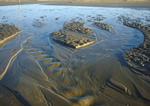Water
Water is well known for its unique chemical and physical properties and is critical in nearly all Earth system processes. Water in minerals and entrained in the lithosphere depresses the melting point of rock, increasing levels of volcanic activity and contributing to an environment that supports plate tectonics. Water is a critical mediator for chemical and mechanical weathering of rock, contributing to the formation of basic soils, and recycling rock materials as sediments.

The water planet
The oceans cover 71 percent of the Earth's surface and contain 97 percent of the Earth's water. Less than 1 percent of water on Earth is fresh water, and 2-3 percent is contained in glaciers and ice caps. Global oceans are critical reservoirs of energy and thermal mass that interact with the atmosphere to define and modulate Earth's climate and moderate rapid changes. Water vapor in the atmosphere is the key factor that controls Earth's albedo and planetary energy balance through cloud formation.
- Ocean Explorer (more info)
Ocean Planet: A Smithsonian Institution Traveling Exhibition (more info)
Ocean Remote Sensing: Sea Surface Temperature Imagery (more info)
Oceanography from the Space Shuttle (more info)
Polar ice
In its solid form, water mantles the polar regions as ice caps that help to regulate the amount of energy reflected into space. The thick ice sheets of Greenland and Antarctica are vast reservoirs of freshwater held in place by the freezing temperatures of the polar regions. Should these icy regions melt, the global sea level would rise significantly. But a drop in temperature could cause a buildup of polar ice and the onset of continental glaciation, another way that water interacts with the land.
-
Factors Affecting the Diurnal Cycle: Clouds and Moisture
MMAB Sea Ice Analysis Page ( This site may be offline. )
The World Glacier Inventory (more info)
Water and life
And of course water is the critical component of life processes - life cannot exist without it. Liquid water provides an environment that harbors life, and offers a pathway for nutrients and energy to be distributed and utilized by living organisms. Over half of the US population lives within 80 km of the coast, and seafood represents 20% of the animal protein in the human diet globally. The availability of fresh water is a factor that limits development and food production in many parts of the world - one third of the worlds population lives in countries with moderate to high water stress. Current consumption and growth trends may double the fraction by 2025.
- Water Quality ( This site may be offline. )
UNEP Freshwater Portal (link to external site) ( This site may be offline. )
- For additional resources see:
National Snow and Ice Data Center (NSIDC) (more info)
Ground Water Atlas of the United States ( This site may be offline. )
National Oceanographic Data Center (more info)
Ocean Biogeographic Information System ( This site may be offline. )
Ocean Portal (more info)
Ocean Remote Sensing: Sea Surface Temperature Imagery (more info)









